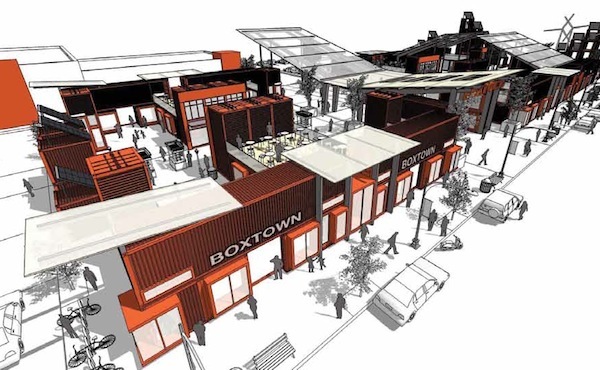Boxman Studios, the recognized leader in modified shipping containers, has launched a new division aimed at sustainable solutions for the Built Environment. The Boxman Studios Buildings Division will focus on the adaptive use of decommissioned shipping containers as architectural elements and even complete buildings.
The company hired veteran sales director Jim Curtis to manage its foray into the Built Environment sector. "Here at Boxman Studios we are fascinated with what we can do with shipping containers. In the right hands, these big metal boxes are extremely pliable," says Curtis. "With our success in the Events and Trade Show industries since 2008, we're perfectly positioned to move into the built environment with a narrative of unique design, modularity, flexibility, and value."
The launch of the new division comes on the heels of Boxman's recent move into a 65,000 square foot facility in North Charlotte. "Our new building means that all facets of an operation are under one roof. We can easily scale as needed," says Boxman Studios' CEO David Campbell. "Launching into container architecture for the Built Environment was a logical next step for our company."
"The Buildings Division will focus on the permanent and semi-permanent use of our creations. We envision modifying containers as structural and design elements in office buildings, retail stores, apartments, multi-family residential, public markets, pop-up restaurants, transit stations, even for emergency response purposes," Curtis added. "We're excited about the next phase in our company's growth."
About Boxman Studios
Founded in 2008, Boxman Studios offers design, development, and deployment services of customized shipping containers, modifying them for a range of markets and applications around the world.
Related Stories
| Mar 1, 2014
Dramatic fractal roof highlights SOM's new Mumbai airport terminal [slideshow]
The terminal merges new technology and traditional regional architecture, notably in the fractal roof canopy that runs throughout the terminal.
| Feb 28, 2014
Six finalists selected in design competition for Canadian Holocaust monument
David Adjaye and Daniel Libeskind are among the finalists for the National Holocaust Monument, planned near the Canadian War Museum in Ottawa.
| Feb 27, 2014
Gensler reveals 44 design trends for the next decade
The 82-page report covers dozens of emerging trends in healthcare, commercial office, hospitality, tall buildings, and more.
| Feb 27, 2014
Target converts former prison dump into latest big-box store
Target's new San Rafael, Calif., location was built on the site of the former San Quentin prison dump.
| Feb 27, 2014
Open or private offices? It depends on the business plan
Open layouts are grabbing headlines as a hallmark of the new workplace—think the Google campus or Facebook's headquarters. And for smaller-scale operations, open designs are often lauded for being less expensive than private office plans. But does that mean all offices should have an open layout?
| Feb 27, 2014
3 reasons to apply computational fluid dynamics on your next project
From right-sizing mechanical systems to understanding the impact of design alternatives, CFD offers a host of benefits for the Building Team.
| Feb 27, 2014
12 facts about heat-treated glass: Why stronger isn’t always better
Glass is heat-treated for two reasons: the first is to increase its strength to resist external stresses such as wind and snow loads, or thermal loads caused by the sun’s energy. The second is to temper glass so that it meets safety glazing requirements defined by applicable codes or federal standards.
| Feb 27, 2014
Metal Construction Association introduces two Environmental Product Declarations
Two Environmental Product Declarations (EPD), one for Metal Composite Material Panels and one for Roll Formed Steel Panels for Roofs and Walls, are now available free of charge from the Metal Construction Association (MCA) on its website.
| Feb 27, 2014
Bluebeam Software launches Revu 12 for better field-ready document management and project collaboration
The latest version of the company’s flagship solution better enables users in document-intensive industries to digitally collaborate on project documents and more easily connect the office to the field.
| Feb 27, 2014
PocketCake lunches CPU designed for virtual reality simulations
The company's Virtual Reality Simulation Converter Assembly is three times more powerful than the average high-performance computer and allows for up to eight people to experience a virtual reality simulation at the same time.

















